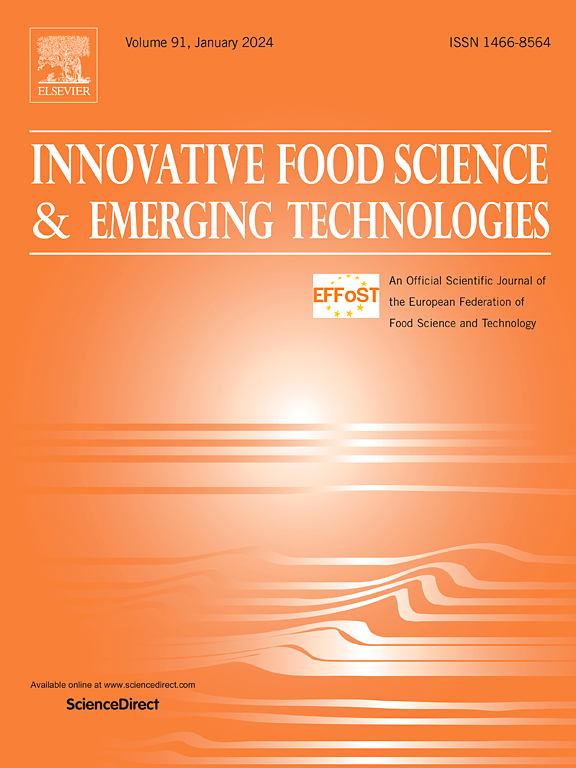基于花青素微胶囊和益生菌自发变化的儿童食品5D打印研究
IF 6.8
1区 农林科学
Q1 FOOD SCIENCE & TECHNOLOGY
Innovative Food Science & Emerging Technologies
Pub Date : 2025-01-05
DOI:10.1016/j.ifset.2025.103921
引用次数: 0
摘要
本研究探讨了微胶囊的特性及其添加对打印特性的影响,并检测了打印样品的pH、益生菌和霉菌数量、风味、质地和颜色随时间的自发变化,通过颜色变化动态指示益生菌的生长水平。结果表明,大豆分离蛋白(SPI)与壳聚糖(CS)复合絮凝对蓝莓花青素实现了高效包封,微胶囊的包封率为87.89±1.16%,微胶囊呈不规则的片段状结构。微胶囊的添加量对打印材料的流变性能、水分分布和打印性能影响最小,微胶囊的最佳添加量为4%。随着培养时间的推移,益生菌的自发生长和代谢产生乳酸、氨基酸、多肽等有机酸等代谢产物,导致打印样品pH值降低。这影响了打印产品中酪蛋白的凝固和淀粉的凝胶化,改善了打印样品的质地特性。在培养过程中,印刷样品的颜色逐渐变红。微胶囊的包封效果增强了颜色响应的时间依赖性,打印样品a*值的变化与益生菌数量的变化相关,相关系数为0.92。4D颜色变化有效地反映了生活的动态变化。通过3D打印的内部结构设计影响了打印样品中益生菌的快速增殖,从而表现为质地、pH值、视觉感觉和风味的差异。本研究为微胶囊化和益生菌在食品添加剂制造领域的应用提供了新的思路。花青素微胶囊和益生菌分别作为智能响应材料和生命活性物质用于食品打印。本研究通过高效4D打印协同益生菌快速添加策略诱导3D打印样品的颜色、风味和质地变化。印刷样品的颜色和纹理变化可以较好地反映寿命动态变化。这为儿童个性化的新奇食品开辟了新的可能性。本文章由计算机程序翻译,如有差异,请以英文原文为准。
Investigation of 5D printing of children food based on anthocyanin microcapsules and spontaneous changes in probiotics
This study explored the characterization of the microcapsules and their addition's impact on printing characteristics, and tested the spontaneous changes in pH, probiotic and mold counts, flavor, texture, and color of the printed samples over time, dynamically indicating the growth level of probiotics through color change. The results showed that SPI (soy protein isolate) and CS (chitosan) achieved efficient encapsulation of blueberry anthocyanins through composite coagulation, the encapsulation rate of the microcapsules was 87.89 ± 1.16 %, with the microcapsules exhibiting irregular fragment-like structures. The addition of microcapsules had minimal impact on the rheological properties, moisture distribution, and printing performance of the printing materials, the optimal addition amount of microcapsules was 4 %. As the culture time evolved, the spontaneous growth and metabolism of probiotics produced organic acids such as lactic acid, amino acids, peptides, and other metabolic products, leading to decrease in pH of the printed samples. This affected the coagulation of casein and the gelation of starch in the printed products, improving the texture characteristics of the printed samples. The color of the printed samples gradually turned red during the cultivation process. The encapsulation effect of the microcapsules enhanced the time-dependency of color response, with the change in a* value of the printed samples correlating with the change in probiotic counts, achieving correlation of 0.92. The 4D color change effectively indicated dynamic changes in life. The design of the internal structure via 3D printing affected the rapid proliferation of probiotics in the printed samples, thereby manifesting as differences in texture, pH, visual sensory, and flavor.
Industrial relevance
This study provides new ideas for the application of microencapsulation and probiotics in the field of food additive manufacturing. Anthocyanin microcapsules and probiotics were utilized as smart-responsive materials and life-active substances for food printing, respectively. In this study, the color, flavor, and texture changes of 3D printed samples were induced by the efficient 4D printing synergistic probiotic fast-addition strategy. The color and texture changes of the printed samples can be a better indicator of life dynamic changes. This opens up new possibilities for the personalization of novelty foods for children.
求助全文
通过发布文献求助,成功后即可免费获取论文全文。
去求助
来源期刊
CiteScore
12.00
自引率
6.10%
发文量
259
审稿时长
25 days
期刊介绍:
Innovative Food Science and Emerging Technologies (IFSET) aims to provide the highest quality original contributions and few, mainly upon invitation, reviews on and highly innovative developments in food science and emerging food process technologies. The significance of the results either for the science community or for industrial R&D groups must be specified. Papers submitted must be of highest scientific quality and only those advancing current scientific knowledge and understanding or with technical relevance will be considered.

 求助内容:
求助内容: 应助结果提醒方式:
应助结果提醒方式:


